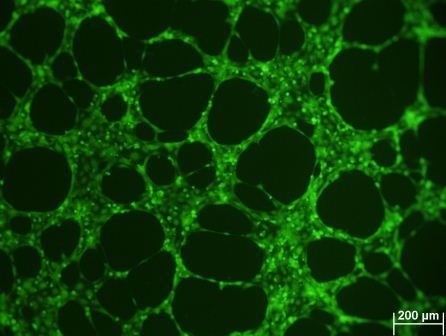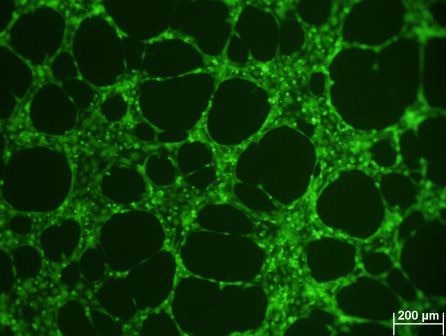Cultrex In Vitro Angiogenesis Assay (Tube Formation) Summary
Cultrex® In Vitro Angiogenesis Assay Tube Formation Kit
The Cultrex In Vitro Angiogenesis Assay Tube Formation Kit (Catalog # 3470-096-K) provides a high-throughput screening platform to test the effects of multiple compounds on endothelial cell tube formation. This kit quantitatively assesses the ability of endothelial cells to form a tube network in a reconstituted protein matrix. The utilization of a fluorescent dye provides data on cell viability and tube network formation in real time.
Features of the Cultrex In Vitro Angiogenesis Assay Tube Formation Kit
- Allows for the detection of inducers and inhibitors of endothelial cell tube formation
- Includes reagents to rapidly and accurately monitor tube formation in real time as well as an inhibitor reagent for control experiments
Kit Contents
- Reduced Growth Factor Basement Membrane Extract
- Calcein AM
- Cell Staining Solution
- Sulforaphane, 10 mM
Data Examples
 View Larger Image | Detection of Angiogenesis Tube Formation. HUVECs were cultured on Reduced Growth Factor-Basement Membrane Extract (RGF-BME) in reduced growth factor-containing media (A), growth factor-supplemented media (B), or growth factor-supplemented media in the presence of sulforaphane, an inhibitor of angiogenesis (C). Angiogenic tube formation was assessed using the Cultrex In Vitro Angiogenesis Assay Tube Formation Kit (Catalog # 3470-096-K). Cells were loaded with Calcein AM, and cell viability and tube formation were detected by fluorescence microscopy. |
Specifications
Product Datasheets
Citations for Cultrex In Vitro Angiogenesis Assay (Tube Formation)
R&D Systems personnel manually curate a database that contains references using R&D Systems products. The data collected includes not only links to publications in PubMed, but also provides information about sample types, species, and experimental conditions.
11
Citations: Showing 1 - 10
Filter your results:
Filter by:
-
Exosomes from chondrocytes overexpressing miR-214-3p facilitate M2 macrophage polarization and angiogenesis to relieve Legg Calv�-Perthes disease
Authors: Lan, X;Yu, R;Xu, J;Jiang, X;
Cytokine 2023-05-27
-
Galectin-1 and -3 in high amounts inhibit angiogenic properties of human retinal microvascular endothelial cells in vitro
Authors: A Hillenmaye, CM Wertheimer, A Geerlof, KH Eibl, S Priglinger, C Priglinger, A Ohlmann
PLoS ONE, 2022-03-23;17(3):e0265805. 2022-03-23
-
Effect of Atmospheric Aging on Soot Particle Toxicity in Lung Cell Models at the Air-Liquid Interface: Differential Toxicological Impacts of Biogenic and Anthropogenic Secondary Organic Aerosols (SOAs)
Authors: S Offer, E Hartner, S Di Bucchia, C Bisig, S Bauer, J Pantzke, EJ Zimmermann, X Cao, S Binder, E Kuhn, A Huber, S Jeong, U Käfer, P Martens, A Mesceriako, J Bendl, R Brejcha, A Buchholz, D Gat, T Hohaus, N Rastak, G Jakobi, M Kalberer, T Kanashova, Y Hu, C Ogris, A Marsico, F Theis, M Pardo, T Gröger, S Oeder, J Orasche, A Paul, T Ziehm, ZH Zhang, T Adam, O Sippula, M Sklorz, J Schnelle-K, H Czech, A Kiendler-S, Y Rudich, R Zimmermann
Environmental health perspectives, 2022-02-03;130(2):27003. 2022-02-03
-
Tumour exosomal CEMIP protein promotes cancer cell colonization in brain metastasis
Authors: G Rodrigues, A Hoshino, CM Kenific, IR Matei, L Steiner, D Freitas, HS Kim, PR Oxley, I Scandariat, I Casanova-S, J Dai, CR Badwe, B Gril, M Teši? Mark, BD Dill, H Molina, H Zhang, A Benito-Mar, L Bojmar, Y Ararso, K Offer, Q LaPlant, W Buehring, H Wang, X Jiang, TM Lu, Y Liu, JK Sabari, SJ Shin, N Narula, PS Ginter, VK Rajasekhar, JH Healey, E Meylan, B Costa-Silv, SE Wang, S Rafii, NK Altorki, CM Rudin, DR Jones, PS Steeg, H Peinado, CM Ghajar, J Bromberg, M de Sousa, D Pisapia, D Lyden
Nat. Cell Biol., 2019-11-04;21(11):1403-1412. 2019-11-04
-
The role of NUDT21 in microRNA-binging sites of EZH2 gene increases the of risk preeclampsia
Authors: X Lang, W Zhao, D Huang, W Liu, H Shen, L Xu, S Xu, Y Huang, W Cheng
J. Cell. Mol. Med., 2019-03-18;0(0):. 2019-03-18
-
Isoliquiritin Apioside Suppresses in vitro Invasiveness and Angiogenesis of Cancer Cells and Endothelial Cells
Authors: A Kim, JY Ma
Front Pharmacol, 2018-12-10;9(0):1455. 2018-12-10
-
Interleukin-33 modulates inflammation in endometriosis
Authors: JE Miller, SP Monsanto, SH Ahn, K Khalaj, AT Fazleabas, SL Young, BA Lessey, M Koti, C Tayade
Sci Rep, 2017-12-20;7(1):17903. 2017-12-20
-
Gastric tumour-derived ANGPT2 regulation by DARPP-32 promotes angiogenesis.
Authors: Chen Z, Zhu S, Hong J, Soutto M, Peng D, Belkhiri A, Xu Z, El-Rifai W
Gut, 2015-03-16;65(6):925-34. 2015-03-16
-
Syndecan-4 is a major syndecan in primary human endothelial cells in vitro, modulated by inflammatory stimuli and involved in wound healing.
Authors: Vuong T, Reine T, Sudworth A, Jenssen T, Kolset S
J Histochem Cytochem, 2015-01-09;63(4):280-92. 2015-01-09
-
Inhibiting NF-kappaB in the developing lung disrupts angiogenesis and alveolarization.
Authors: Iosef C, Alastalo T, Hou Y, Chen C, Adams E, Lyu S, Cornfield D, Alvira C
Am J Physiol Lung Cell Mol Physiol, 2012-02-24;302(10):L1023-36. 2012-02-24
-
Tumor cell-derived angiopoietin-like protein ANGPTL2 is a critical driver of metastasis.
Authors: Endo M, Nakano M, Kadomatsu T, Fukuhara S, Kuroda H, Mikami S, Hato T, Aoi J, Horiguchi H, Miyata K, Odagiri H, Masuda T, Harada M, Horio H, Hishima T, Nomori H, Ito T, Yamamoto Y, Minami T, Okada S, Takahashi T, Mochizuki N, Iwase H, Oike Y
Cancer Res, 2012-02-16;72(7):1784-94. 2012-02-16
FAQs
-
What is the Tube Formation Assay?
The Tube Formation Assay is based on the ability of endothelial cells to form three-dimensional capillary-like tubular structures when cultured on a hydrogel of reconstituted basement membrane, such as Cultrex Basement Membrane Extract (BME).
-
What are the advantages of the Tube Formation Assay?
The Tube Formation Assay is the most widely used in vitro angiogenesis assay. The assay is rapid, inexpensive and quantifiable. It can be used to identify potentially angiogenic and anti-angiogenic factors, to determine endothelial cell phenotype, and to study pathways and mechanisms involved in angiogenesis. It can be performed in a high throughput mode to screen for a large number of compounds.
-
What cell types can be used in the Tube Formation Assay?
The Tube Formation Assay is specific for endothelial cells, either primary cells or immortalized cell lines. Only endothelial cells form capillary-like structures with a lumen inside. Other endothelial cell types form other structures.
-
What are the variables associated with the Tube Formation Assay?
The major variables associated with tube formation are composition of the Cultrex Basement Membrane Extract (BME) hydrogel, thickness of the hydrogel, cell density, composition of angiogenic factors in the assay medium, and assay period.
-
How do I reduce spontaneous formation of tubular structures on Cultrex BME in the absence of angiogenic factors?
Primary endothelial cells, such as Human Umbilical Vein Endothelial Cells (HUVECs) form capillary-like structures in the absence of added angiogenic factors less often than immortalized endothelial cells. Generally, reducing the number of cells per cm2 plated onto Cultrex BME will result in less background or spontaneous tube formation. Titrate the number of cells and find optimal conditions for your specific cell line. When endothelial cells fully form capillary structures in response to angiogenic activators, but not in their absence, you may proceed.
-
Which Cultrex Basement Membrane Extract (BME) should I use for the Tube Formation Assay?
Cultrex Reduced Growth Factor BME (RGF BME) is generally used for testing compounds that promote angiogenesis because formation of capillary-like structures (tubes) is significantly less compared to non-growth factor reduced varieties of Cultrex BME. The Cultrex In Vitro Angiogeneis Assay (Tube Formation) includes a qualified production lot of Cultrex RGF BME that exhibits reduced background tube formation in the absence of angiogenic factors.
Reviews for Cultrex In Vitro Angiogenesis Assay (Tube Formation)
Average Rating: 4.7 (Based on 3 Reviews)
Have you used Cultrex In Vitro Angiogenesis Assay (Tube Formation)?
Submit a review and receive an Amazon gift card.
$25/€18/£15/$25CAN/¥75 Yuan/¥2500 Yen for a review with an image
$10/€7/£6/$10 CAD/¥70 Yuan/¥1110 Yen for a review without an image
Filter by:



